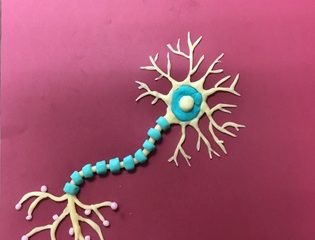Here’s what we are reading today:
“A research team led by Brown geologist Pete Schultz has found fragments of leaves and preserved organic compounds lodged inside glass created by a several ancient impacts in Argentina. The material could provide a snapshot of environmental conditions at the time of those impacts. The find also suggests that impact glasses could be a good place to look for signs of ancient life on Mars.”
“”It is always difficult to put a value on the connection between meteorites and the origin of life; for example, earlier work has shown that vitamin B3 could have been produced non-biologically on ancient Earth, but it’s possible that an added source of vitamin B3 could have been helpful,” said Karen Smith of Pennsylvania State University in University Park, Pa. “Vitamin B3, also called nicotinic acid or niacin, is a precursor to NAD (nicotinamide adenine dinucleotide), which is essential to metabolism and likely very ancient in origin.” Smith is lead author of a paper on this research, along with co-authors from NASA’s Goddard Space Flight Center in Greenbelt, Md., now available online in the journal Geochimica et Cosmochimica Acta.”
“Myelin, the electrical insulating material long known to be essential for the fast transmission of impulses along the axons of nerve cells, is not as ubiquitous as thought, according to a new work lead by Professor Paola Arlotta of the Harvard Stem Cell Institute (HSCI) and the University’s Department of Stem Cell and Regenerative Biology, in collaboration with Professor Jeff Lichtman, of Harvard’s Department of Molecular and Cellular Biology.”
“Close your eyes and imagine home. Sharp details—such as the shape of the front doorknob, the height of the windows, or the paint color—assemble in your mind with a richness that seems touchable. A new study has found where this mental projection lives in the brain by inducing hallucinations in an epilepsy patient. “
“Once inside, the gynosome inflates, deploying spines that anchor the pair for sexual bouts lasting as long as 70 hours (not a typo). The connection is so strong, in fact, that researchers trying to pry a pair apart “led to separation of the male abdomen from the thorax without breaking the genital coupling.””
“Play-i was founded with the mission to bring the joy and magic of programming to every child. We want Bo & Yana to also reach children who cannot afford them. This is where you come in. Every dollar you contribute will go towards robots for schools and organizations that serve underprivileged children.”
“The study, led by Amita Sehgal PhD, professor of Neuroscience and a Howard Hughes Medical Institute (HHMI) Investigator, linkssleep disruption in newborn fruit flies with a critical adult behavior: courtship and mating.
The team, addressed sleep in the very youngest of flies. “These flies sleep considerably more than adults and that behavior repeats across the animal kingdom,” Sehgal says. “Infant humans, rats, and flies, they all sleep a lot.””




5 Comments
oliviaeinbund · April 20, 2014 at 9:59 am
Hallucinations and deep brain stimulation: This article intrigued me! I can close my eyes and picture my home so accurately, however I do not hallucinate. I find it very interesting that the people who do hallucinate are those that suffer from epilepsy. The article did not go in depth as to why epilepsy caused hallucinations, it simply stated it has to do with the PPA. I wish the article was longer because it was very fascinating.
oliviaeinbund · April 20, 2014 at 10:04 am
Play-i: This is a toy of the future! However, is it beneficial? I wonder what its effects will be on the child that uses it. This article raised a lot of questions for me. In my experience, I never played with such high-tec (and expensive!) toys as a child. Did I miss out? Are such toys necessary to “give flight to my child’s imagination”? Will Bo truly open new doors for children, a door that a well written book or creative board game will not open? It seems very fun, different, and insightful, yet I am not fully convinced children need such toys.
shanpolley · April 21, 2014 at 8:52 am
Hallucinations and deep brain stimulation: It’s interesting that a one-time swelling of the brain at a young age could cause such permanent damage for the rest of someone’s life. I have always thought that children’s bodies are more resilient than adults, so to think that even swelling in a child’s brain doesn’t heal shows how sensitive and important the brain really is. I’d be curious to know what part of the brain is responsible for déjà vu, although it is interesting to discover the part of the brain responsible for hallucinations and a little bit of memory recall.
shanpolley · April 21, 2014 at 9:13 am
sleep deficits and sexual disruption: Although it was found that sleep disrupts flies ability to reproduce, I wonder how relatable that is to humans. Flies have such a different life span, behaviors, environmental conditions, and reproductive rates than humans, and humans are far more complex than flies. It brings up the question of what other factors play into human reproductive ability besides sleep, and if our “nurturing” as a child based around how much sleep we receive when we’re young will affect our ability to have children in the future. Personally, I don’t think the amount of sleep we receive in our youth is the game-changer on whether or not we will have kids in the future; I think there are many, many other factors that are far more important including those that go beyond biology and into sociological and economic factors.
nfreche · May 17, 2014 at 9:58 pm
Was Vitamin B3 made in space?:
From previous knowledge I know that vitamin B3, or commonly known as Niacin, is found in a variety of sources such as dairy products, eggs, cereal, lean meats, fish, and legumes. Like the article mentioned, Niacin is important in metabolism since it is a precursor to NAD. I’ve learned that NAD is important in the electron transport chain, which results in the synthesis of ATP. Since I’ve only studied vitamin B3 on a metabolism level, I would have never thought that Niacin could have been made in space and brought down to Earth by meteorites. I find this fascinating since I’ve only thought of Niacin as nutrient, and not a key molecule in the forming the solar system.